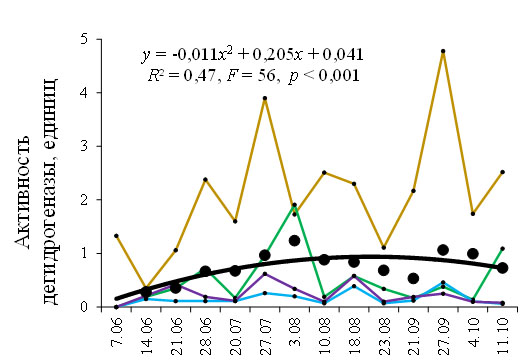Seasonal activity of anaerobic dehydrogenase of peat soils as related with some chemical factors of the redox environment of drained forest mires
DOI:
https://doi.org/10.31251/pos.v7i2.256Keywords:
seasonal fluctuations trend; increase rate; decrease rate; mobile forms of iron; water-soluble organic matter; canonical analysis.Abstract
The aim of the study was to study the specifics of seasonal fluctuations of anaerobic dehydrogenase of peat soils under the influence of forestry hydromelioration, a powerful exogenous factor affecting the speed and direction of biochemical processes.
Location and time of the study. The southern taiga one of West Siberia during June–October 2001–2003 (geographical coordinates 56°23'071" NL, 84°34'04" EL).
Methods. Investigation of the seasonal dynamics of the activity of anaerobic dehydrogenase and chemical components of the soil environment – C, NH4+, Fe2+, Fe3+, Fec (associated with organic matter) using the method of systemic ecological analysis.
Results. The profile of drained forest peat soils was clearly differentiated into three zones: 0-5 cm of high anaerobic dehydrogenase activity, 5-10 cm of moderate activity and 10-30 cm of low activity of the enzyme. The main trend in seasonal fluctuations of the dehydrogenase activity from June to October was approximated by a second-order parabola. According to the regression equation parameters, in poorly drained soils the weekly increase in dehydrogenase activity averaged 0,205 units with a weekly average deceleration of 0,022. In the strongly drained soils, there was a weekly deceleration by an average of 0,131 with a weekly average acceleration of 0,022 units. Positively increased activity of anaerobic dehydrogenase was measured in 0-5 cm soil horizons, with the highest rates detected under poor drainage. Downwards the profile, there was mainly a negative increase during the entire observation period. A functional relationship between the activity of anaerobic dehydrogenase, mobile forms of iron, water-soluble organic matter and ammonium of medium and high density according to the type of parabola was revealed.
Conclusions. The chemical components of the aqueous extract are the most important environmental factors controlling the kinetics of enzymatic reactions of peat soils. The cumulative proportion of the explained dispersion of dehydrogenase activity by mobile forms of iron (Fe2+, Fe3+, Fec) was 61 and 41%, by biogenic elements (organic matter and NH4+) – 25 and 44% respectively in weakly and intensively drained soils. The dominant factors determining seasonal fluctuations of the enzyme are iron-organic complexes and ammonium, regardless of the drainage regime, and oxidized iron under poor and reduced iron under strong drainage, respectively.
Downloads

Downloads
Published
How to Cite
Issue
Section
License
Copyright (c) 2024 The Journal of Soils and Environment

This work is licensed under a Creative Commons Attribution 4.0 International License.






